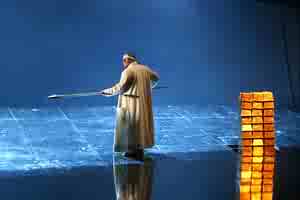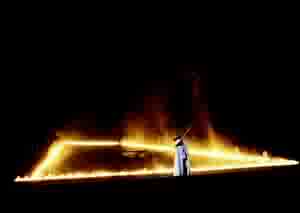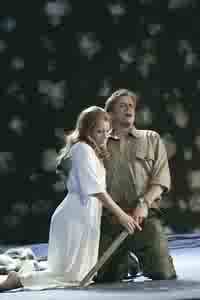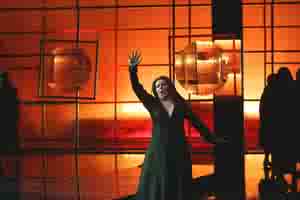|
Editor: Marc Bridle
Webmaster: Len Mullenger
|
Seen
and Heard Opera Review
Musical Director:
Ralf Weikert Lighting: Kimmo Ruskela Selected Cast List Wotan / Wanderer:
Juha Uusitalo Erda /Schwertleite: Erja Wimeri Sieglinde:
Nina Stemme Mime (Siegfried): Arild Helleland Hunding / Hagen:
Matti Salminen Brünnhilde: Susan Marie Pierson Siegfried: John Treleaven Waltraute (Götterdämmerung): Laura Nykanen
Juha Uusitalo as Wotan
First things first: this is a world class ‘Ring’ which must rank among the finest anywhere at the moment. Although it is a revival of Götz Friedrich’s first complete staging from 2000, this version has (mostly) excellent principals, a fine new conductor and remarkably assured direction from Friedrich’s original assistants. Faithfully reproduced by Anna Kelo from Friedrich’s detailed notes, the production has developed into something very special, and while criticisms can fairly be made of its Siegfried and Brünnhilde, it is satisfying musically, looks spectacular and remains sensitive to the text. Altogether, a most distinguished effort.
Initially (from the 1996 Rheingold onwards) the production was reckoned to be a shocker. It has bare-breasted Rhinemaidens, Valkyries cavorting with dead naked warriors, five Woodbirds with too few feathers to spare their blushes, and Gibichung siblings whose relationships are cosy, to say the least. After Beixto and Schlingensief of course, this all feels perfectly comfortable these days, and in any case the production is otherwise so coherent that anyone likely to be offended will easily be won over by its virtues.
Gottfried Pilz’s simple geometric set designs have always made an important contribution. When coupled with Kimmo Ruskela’s exceptional lighting plots, they provide a visual experience that is never less than interesting and more often than not is thrilling. FNO’s large stage can cope with all the technical problems that modern opera presents: it rotates, elevates halfway to the proscenium arch and accommodates seriously chunky scenery. The Rhine for instance, is suggested by suspended green and blue neon tubes that span the whole stage and move with the music in rhythmical wave patterns. Nibelheim is an underground factory filled with high tension electrical equipment which rises up through the stage: it has powerful flashing signs spelling DANGER or from certain perspectives ANGER and is dark, smoky, and frightening. The most spectacular effects however, involve pyrotechnics: Brünnhilde’s rock is protected by dramatically fierce fire with flames that belch smoke in profusion. And when Valhalla finally collapses, it does so literally, amid more flame behind the neon of the gently rolling Rhine.
One of the most gratifying aspects of Finnish National Opera is its ability to stage major productions with a largely home-grown team. There is Matti Salminen of course, stern and forbidding as Hunding, sinister and downright evil as Hagen and with his huge voice currently at its absolute best. But that’s almost the least of it: this production also has Juha Uusitalo as an effortless, majestic and even peerless new Wotan. At the risk of hyperbole - Uusitalo’s voice seems potentially limitless throughout its whole compass, he doesn’t tire at any point in this huge role, he has impeccable diction and a commanding characterisation of the part - I’d venture to suggest that this is as good as Wotan gets. Extraordinary, wonderful, memorable….All of these and then some.
In the normal way of things, a home-team fielding two great singers would be rather better than noteworthy, but there is more to come. Esa Ruuttunen (a Wotan from earlier productions) appears as a darker voiced, scruple-free and agile Alberich, Jorma Silvasti sings tunefully as the wiliest of Loges, Erja Wimeri is a solemn and resonant Erda and there’s a brand new Held in the form of Jyrki Anntila. More of him later, but to complete the home side round-up, mention should also be made of fine performances by Jyrki Korhonen (Fafner) and Laura Nykanen (Waltraute in Götterdämmerung.)
Of the imports, Susan Marie Pierson’s Brünnhilde is the least successful. She has appeared in all the revivals (the role was shared initially between her and Karan Armstrong) and while it is obvious that her confidence and characterisation have improved over the years, sadly her voice has not. Pierson has always had a big sound, extraordinarily loud during both the Awakening scene in Siegfried and the Götterdämmerung finale in this revival, but she has also suffered from a troublesome vibrato which has now become a serious wobble. A Finnish reviewer reported apparently, that she .. ‘did not quite manage to spoil this Ring.’
The Cornish-born tenor John Treleaven is a new-comer to Helsinki’s Wagner and Stig Anderson’s Siegfried in the last revival must have been a hard act to follow. John Treleaven has sung most of the heldentenor repertory since his debut in 1979, and acquitted himself nicely. Although his is not a big voice, it is easy on the ear and was generally free from strain in this production. He appears at Covent Garden in 2005 and 2006, and is surely worth hearing again.
Arild Helleland is another Helsinki stalwart, though he comes, in fact, from Norway. His Mime (in Siegfried only, it was sung by Aki Alamikkotervo in Das Rheingold) is wonderfully polished these days, weedling and threatening by turns. He knows the role backwards and it shows.
Nina Stemme and Jyrki Anttila
And so (as they say) to Nina Stemme and another triumphant performance. ‘Mortgage your Grandmother,’ I wrote in the review of her Stockholm Isolde in February, to hear her. Well, do it (or your children, your car or your little place in Spain.) You won’t regret it, for hers is one of the best Wagner voices in the world without question. Yet another effortless instrument and one of extraordinary power and beauty at that, this voice will surely sing Brünnhilde one day, and so it should. I cannot remember a better Sieglinde (and Stemme is still young) or a finer Act I of Die Walküre for that matter, where Stemme was partnered by Salminen and Anttila. Salminen is just Salminen and that’s all that need be said, but Anttila is a hero in the making. At the moment, there is something of a baritone tinge to his lower range and his pitch at that level isn’t always perfect. Having heard him in non-Wagner roles however, I am sure that he has found his forte and expect him to develop.
The final ‘importee’ is Ralf Weikert, a very experienced Wagnerian indeed, as Musical Director. While Leif Segerstam had coached the orchestra to play the work in previous productions (Wagner is even now a relatively recent arrival at FNO) his performances were not always well received and some of them suffered from distinctly patchy ensemble. Experience pays off however and the orchestra responded to Maestro Weikert handsomely. Solid, secure and most of all deeply expressive playing was the result on this occasion. Another revival is planned for 2008 and on the strength of the experience gained so far, it promises to be particularly important. Booking early would be my advice.
Bill Kenny
Susan Marie Pierson as Brünnhilde
Back to the Top Back to the Index Page
|
|
||
|
||||






